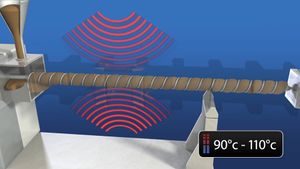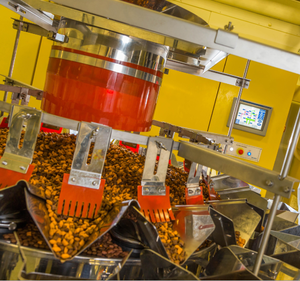Dry Pet Food Manufacturing
Overview
Dry pet foods are made by mixing dry and wet ingredients together to form a dough. In the extrusion process, the dough is heated under pressure, then pushed through a die machine that cuts the kibbles. Kibble size and shape varies according to the product specification. The kibbles are dried, cooled and spray coated. Some dry foods may also be produced by means other than extrusion, such as baking.
Ingredient Selection and Sourcing
Many of the ingredients used in the manufacture of pet food are described as animal (or fish) derivatives or by-products. These ingredients are the parts of the animal surplus to the requirements of the human food industry. In dry pet foods, animal derivatives are commonly used in a meal form (such as chicken meal, poultry by-product meal) where meat and animal derivatives are cooked, the fat removed and the remaining material dried to create a dry meal. By-products may be used in fresh or frozen form. Many of the other ingredients such as cereals, grains, and vegetables used in dry pet foods come in dry form and are milled or ground prior to mixing. A recipe is also likely to include oils and fats, vitamins and minerals required to ensure the product delivers all the essential nutrients.
Ingredient Weighing and Preparation
Ingredients are carefully selected according to a pet food manufacturer’s specific recipe, formulated to deliver complete and balanced nutrition for cats and dogs. Dry ingredients are ground and sieved where required and then mixed.
Cooking and Cooling

The dry mix is combined with wet ingredients, water and steam in a preconditioner, which hydrates the powders, creates a dough and starts the cooking process. The dough then enters a machine known as an extruder, which cooks the dough under pressure. The dough exits the extruder under pressure through a die plate creating ribbons of pre-specified shapes that are then sliced into the pre-specified size using a rotary cutter.
After extrusion and cutting the kibbles are air dried in an oven to remove moisture and then cooled. Reducing the moisture content is an important step in maintaining freshness and preventing food spoilage.
When baked, the dough is rolled out and cut into shapes, then baked in an oven (similar to cookies or biscuits).
Kibble Coating
After drying and cooling, kibbles often enter a revolving drum where they are evenly coated with a mix of flavours to enhance taste, and preservatives to prevent spoilage through the shelf life of the food. Flavours or other coatings may also be sprayed on baked foods as they exit the oven.
Packaging
Packs are filled according to the declared weight of the product and the packaging is appropriately sealed to prevent contamination.
Storage and Distribution
Packages are stored in boxes or wrapped on pallets and stored in warehouses ready for distribution to customers.
| Dry Pet Food Manufacturing Learning Resources | |
|---|---|
 Selection of relevant videos |
Extruder animation |
| This article was: Date reviewed: April 2017 |
| Endorsed by Mars Petcare, the world’s leading pet nutrition and health care business that strives to make A Better World for Pets every day. | 
|
Webinars
Failed to load RSS feed from https://www.thewebinarvet.com/gastroenterology-and-nutrition/webinars/feed: Error parsing XML for RSS
